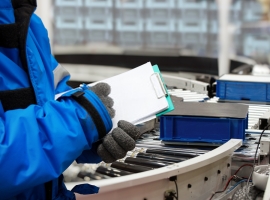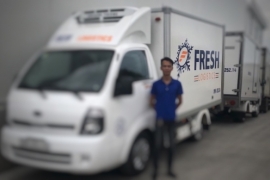COLD STORAGE PROCESSES THAT ENTERPRISES NEED TO KNOW!
Refrigerated preservation plays a very important role in the business of many individuals/businesses today. Correct understanding and good implementation of refrigerated preservation processes will help businesses reduce the loss of goods, maintain product quality and CREATE MORE PROFITS FOR THE BUSINESS!
Nam Ha Noi cold storage will share with readers and businesses useful information about this process. Follow along in the following post!
Refrigerated preservation: Reduce loss, avoid waste in production - business in our country!
Vietnam is still a tropical agricultural country with over 80% of the population living on agriculture, annual output reaching 71,473 trillion VND and accounting for 13.85% of gross domestic product*.
*Statistics from the General Statistics Office of Vietnam in 2009.
Our country's agricultural/livestock/fishing products such as vegetables, fruits, meat, aquatic products, seafood and other by-products are always plentiful and need to be preserved and processed.
.jpg)
However, the preservation of agricultural products in our country is still limited and inconsistent, leading to serious losses. May be mentioned the loss of one of the most typical products in Vietnam - rice.
According to FAO survey data, the post-harvest loss of rice in Vietnam is about 10% to 37%. In particular, the loss during the preservation period can be up to 6% when the storage conditions are too poor.
In the preservation process, the loss of agricultural products is manifested in two forms: weight loss and quality deterioration.
While increasing productivity by 1% at plantations is extremely difficult for farm owners, poor preservation of agricultural products after harvest will cause product quantity and quality to be greatly reduced compared to the initial output.
Therefore, preserving and maintaining the product quality obtained after harvesting/slaughtering/processing should be a top priority for farm owners, distributors and retailers in the time when the market economy flourished!
Among agricultural storage methods, cold storage is the best method applied by many businesses/farmers today! So...
What is refrigerated preservation?
Refrigerated preservation is a method to reduce the temperature of food, slow down the physiological, biochemical and metabolic processes of the product, limit the loss in volume/quality of goods, and prolong the shelf life to use for commercial, export & consumption purposes. To apply this method in practice, it is necessary to have different preservation methods for each specific product, known as refrigerated preservation process.
Properly implementing the refrigerated preservation process in production and business helps to solve the problem of preserving/processing agricultural products, increasing income for people and businesses will benefit from the distribution/export of goods.
So, what kind of goods can be applied refrigerated preservation process? How is it done? Let's keep reading with Nam Ha Noi cold storage in part II.
Instructions on applying cold preservation process to each type of goods in business
What refrigerated preservation processes are being used in production and business today? What are the ways to do and the things to keep in mind when applying this process? Nam Ha Noi cold storage will guide businesses to carry out the refrigerated preservation process for each type of goods, specifically as follows:
Refrigerated preservation process of agricultural products
Loss in weight and quality of agricultural products during storage is inevitable when producing and trading this type of product. However, refrigerated preservation of agricultural products will help businesses somewhat reduce this situation, at least a lot more than when storing dry!

.jpg)
Refrigerated preservation of agricultural products - How to better keep products in production and business
Weight loss occurs when there is a decrease in the volume of agricultural products as a result of physical and biological phenomena, the reproduction of harmful insects and molds during storage. For example, when the particle is self-heating, the loss in weight will be about 3% to 8%. The loss can be unlimited if rats and birds sabotage.
Quality loss occurs when agricultural products are stored longer than their shelf life (the period which the product retains its food properties). The decrease in quality of agricultural products is also due to early germination, biochemical changes, the impact of microorganisms that produce secondary products (Mycotoxins) or insects, spoilage and contamination by rats and birds as well as mechanical friction.
When agricultural products are refrigerated, they fall into a dormant state that physiological and biochemical processes take place very slowly, metabolism also stops, thus limiting the loss of mass. Refrigerated preservation of agricultural products will help individuals/businesses prevent the impact of microbial or biochemical factors on agricultural products.
Refrigerated preservation process of agricultural products
Refrigerated preservation of agricultural products happens in two main stages as follows:
Stage 1 - When agricultural products are first putting into cold storage: Humidity is about 70%, temperature is 18oC to 20oC, low oxygen and light condition within 10 to14 days.
Stage 2 - After phase 1 ends: Maintain temperature between 2oC to 4oC, humidity 90 to 95% for most of the remaining cold storage period.
The detail refrigerated preservation process of agricultural products:
Harvesting → Preliminary processing (selecting and removing bad/insect products, cleaning, removing impurities) → Packing (in bags, pineapple bags, sacks, jute bags, etc. to ensure ventilation and does not affect the respiration of agricultural products) → Put in cold storage → Arrange agricultural products in cold storage (in rows, so that the air and humidity circulate well) → Adjust the temperature in the cold storag by stage.
Note: For agricultural products, potatoes should be put into cold storage from the 10th to 20th day after harvested. If we store potatoes right after harvesting, at this time the skin is often weak while the water content in the tubers is high, which will affect the quality of the potatoes. If we put potatoes in storage too late, the potatoes may rot and affect the quality of the bulbs.
In addition, for the same agricultural product, the storage conditions also need to be different depending on the different purposes of use. Storage of seed potatoes needs light and good ventilation while storage of potato needs dark and limited ventilation, etc.
Refrigerated preservation process of frozen meat
Meat is one of the most perishable foods if not stored properly. People from the past have had many ways to preserve meat longer such as salting, drying, etc., but these ways make the meat no longer retain its freshness as before. Preserving meat by freezing method today is concerned and used by a lot of people. With the freezing method, frozen meat will keep its freshness longer without any changes in quality.
.jpg)

Preserving meat by freezing does not change the nutrients of meat.
Refrigerated preservation process of aquatic products and seafood
Aquatic products and seafood are also perishable foods but can be kept fresh through the process of freezing or salting. Aquatic products and seafood can also be degraded over time and reduce quality if not carefully preserved, especially easy to stale or dry when exposed to high temperatures for a long time.
The preservation process of aquatic products and seafood includes:
(1) Cleaning and preliminary processing of aquatic products - seafood materials. Some foods after preliminary processing will reduce in weight compared to the original → (2) Weigh the volume of the consignment obtained after preliminary processing → (3) Put aquatic products and seafood into moulds/styrofoam boxes/packaging to preserve → (4) Freeze aquatic products and seafood to the product's core temperature (about -12oC) in a cold cellar about -45oC → (5) Put in cold storage for preservation.
Note: The reason why businesses need to freeze aquatic products and seafood in a deep cold cellar is to prevent the product from being decomposed, losing water in the cell bonds, keeping the food as it was at the beginning as well as not losing nutrients in seafood when defrosting.
Refrigerated preservation process of fruits and vegetables
Vegetables and fruits can be completely dry preserved at normal temperature, but they are easily affected by physical and biological factors leading to rapid wilting, crushing, rapid ripening, internal rot, etc. Refrigerated preservation is the method to help vegetables stay fresh, retain all nutrients and store longer.
.jpg)
The color of vegetables and fruits is completely preserved when refrigerated
The preservation process of fruits and vegetables will be:
(1) Collecting from garden/plantation → (2) Filter out damaged/infested fruits and vegetables, keep the intact and qualitative finished products → (3) Clean vegetables, wait to drain, then pack them → (4) Put in cool preservation.
Note: Cold storage to preserve fresh fruits and vegetables requires humidity of 90 to 95%, temperature from 0oC to 12oC, oxygen content of 5 to 10% and keeping in dark light condition.
Below is a detailed description of way to preserve food:
| Type of product | Detailed description | Storage time at -18oC (frozen) | Preservation method |
| Meat | Pork ribs or pork with ribs | 4 - 6 months |
Raw meat needs to be cleaned before putted in the freezer for preservation. You should note to cover many layers to prevent the meat from being too frozen, leading to the dehydration or color and taste changes. |
| Roasted pork | 4 - 12 months | ||
| Beef tenderloin | 6 - 12 months | ||
| Beef ribs | 4 - 6 months | ||
| Roasted beef | 12 months | ||
| Whole chicken | 12 months | ||
| Shared chicken | 9 months | ||
| Roasted chicken | 4 months | ||
| Fried breaded chicken | 1 - 3 months | ||
| Minced pork | 3 - 4 months | ||
| Seafood | Boneless fish meat | 6 months | Similar to meat, you also need to wrap seafood thoroughly with several layers to avoid spreading the smell through other foods. Note that you should prepare seafood before putting them in the freezer. |
| Cooked fish | 4 - 6 months | ||
| Smoked fish | 2 months | ||
| Shellfish (clams, oysters, snails) | 2 - 3 months | ||
| Lobsters | 12 months | ||
| Crabs | 10 months | ||
| Fresh shrimp, scallops | 3 - 6 months | ||
| Squids | 3 - 6 months | ||
| Fruits and vegetables | Các loại quả mọng nước (cam, quýt) | 3 months | Fruit and vegetables should not be stored in airtight bags or containers. We recommend that you keep them in a food bag and keep it in the refrigerator to keep vegetables and tubers always fresh and delicious. |
| Other fruits | 9 - 12 months | ||
| Nuts | 3 months | ||
| Vegetables | 8 - 12 months |
Implementing the standard refrigerated preservation process will ensure the product quality, increase shelf life, reduce loss, and provide the processing industry with good raw materials to produce more export goods as well as increase national income and improve living standards.
Popular asked questions of enterprises about the refrigerated preservation process
With more than 20 years of experience in the frozen food industry, Nam Ha Noi Cold Storage will summarize the most popular asked questions by businesses today.
Is frozen food safe and healthy?
Many people think that frozen food is not safe because of the opinion that the freezing method can cause food to lose nutrients, degrade and become toxic. However, this is not true at all!
Freezing slows down the decomposition of food, preventing bacteria, mold, and yeast from growing even though the product is still adequate in terms of quality and nutrition. Therefore, food will always be safe and healthy if it is stored in cold storage (at the right temperature).
Frozen foods are often low quality?
Many scientific studies prove that the refrigerated preservation process does not destroy nutrients as well as reduce the quality of food. Typically meat and poultry foods - the nutritional value changes little after freezing the product.
However, some have noticed that the bone marrow/meat near the bones of poultry becomes darker when refrigerated and consider this to be a sign of deterioration in the product. But that's not true! The cause of bone color change is due to the pigment from the marrow penetrating through the spongy bone, infecting the surrounding meat fibers during freezing and defrosting of poultry meat.

In addition, the freshness and quality of the food at the time of freezing will affect the condition of the product after defrosting. The fresher and higher the quality, the more nutrients, color, flavor and texture will be retained when defrosted.
Does frozen meat contain carcinogenic toxins if stored for too long?
There is no specific scientific evidence that using frozen foods will cause people to get cancer, at least until today.
It is true that there is a change in quality if frozen meat is stored for a long time, but there are no harmful toxins to the user's health. With frozen meat, there is no production of toxins but only protein denaturation, oxidation and rancidity during freezing. Specifically, at a temperature of -12oC or -14oC, Myosin, a protein found in meat muscles will be precipitated and washed away when defrosting meat, pulling other nutrients out of the food. As a result, the sweetness of the meat will be poor, the quality of the meat will not be as chewy as when the meat is fresh.







